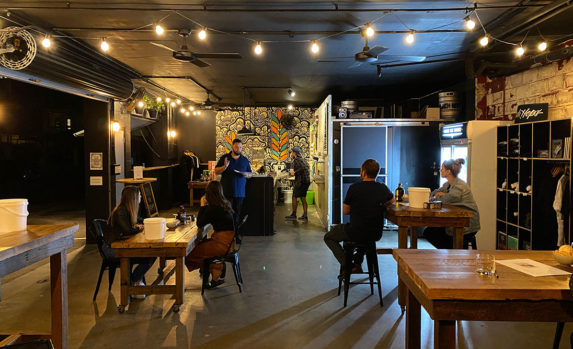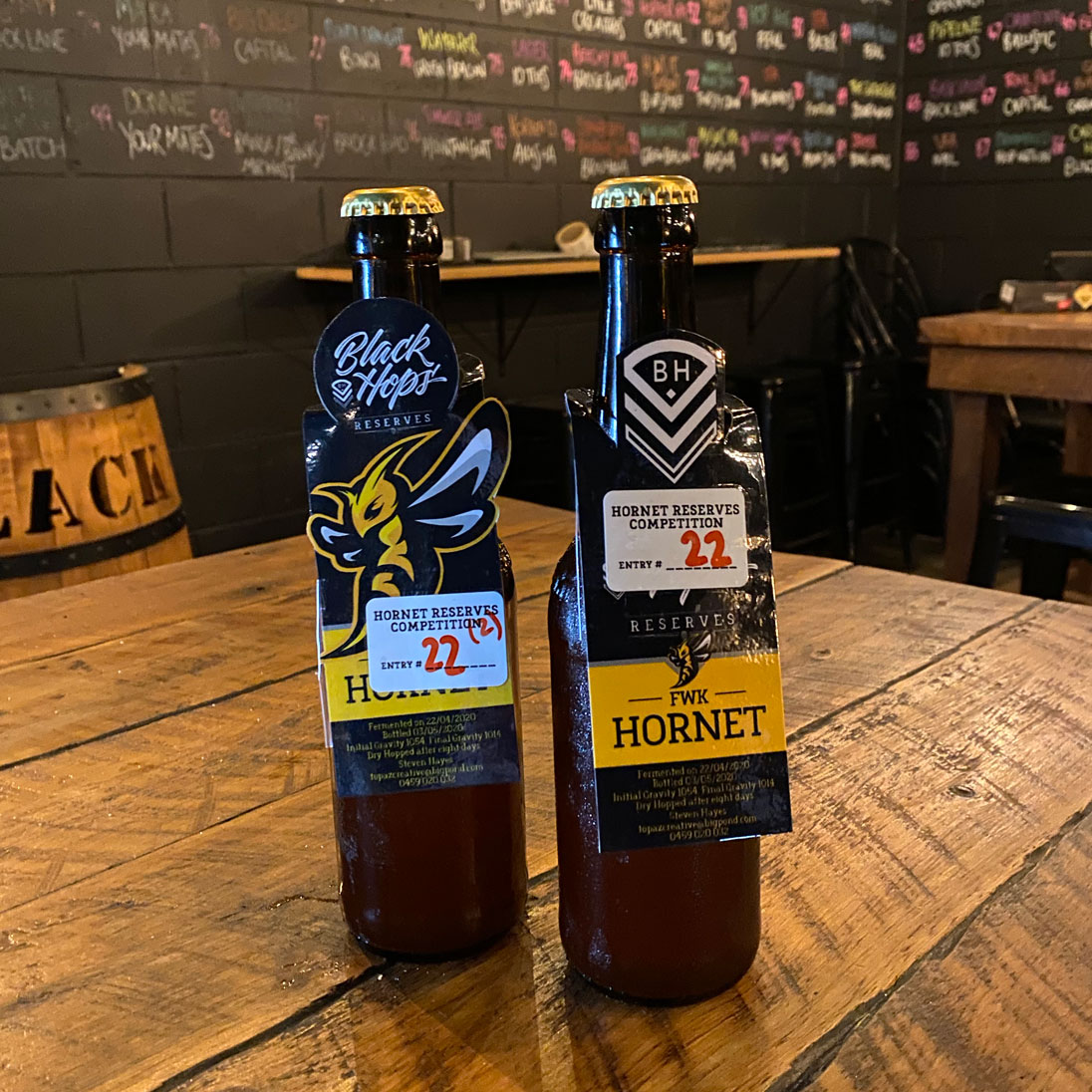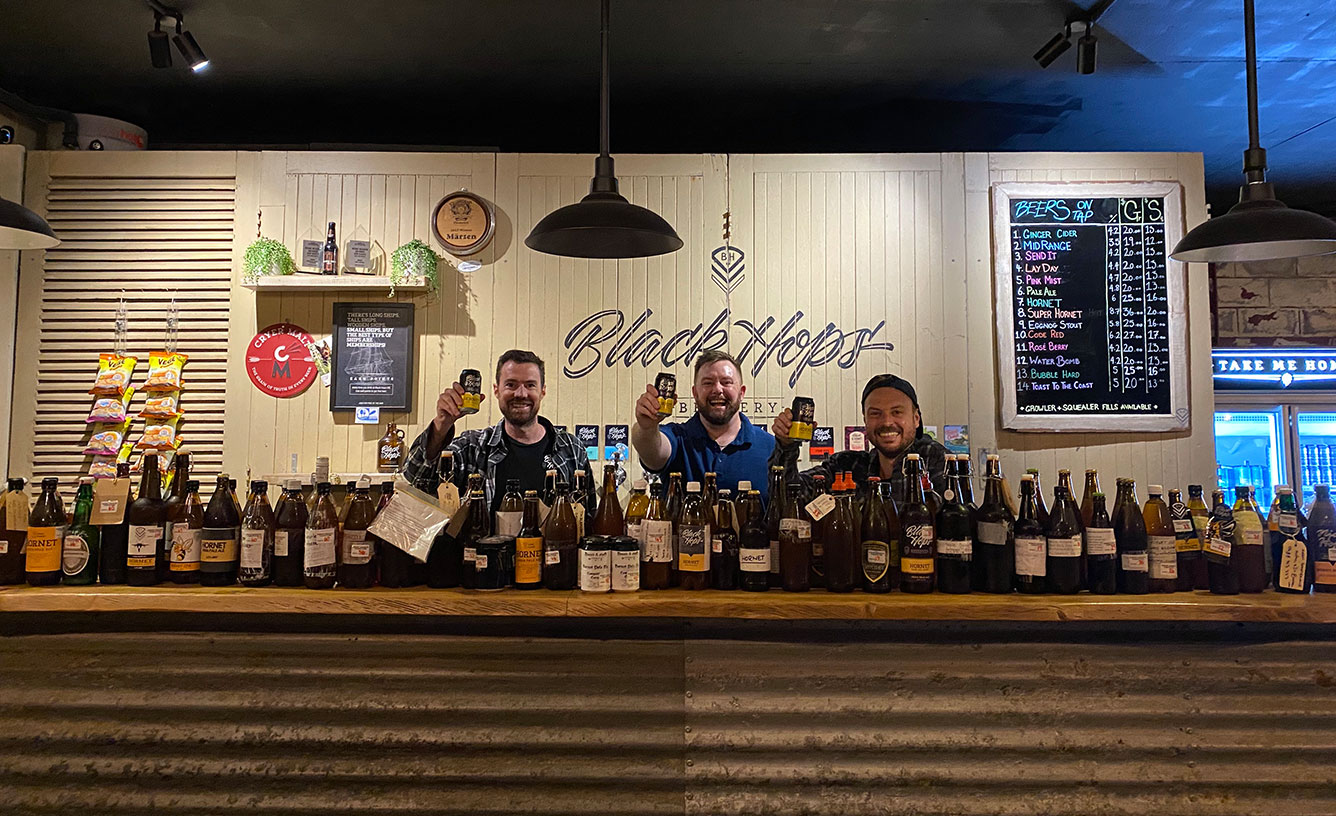On Friday, 29 May the official judging took place for the first round of our Black Hops Reserves Brew At Home Comp.
We received 75 entries for our Round 1 beer, Hornet IPA. Our judging panel had a lot of fun sampling the entries and awarding rankings, based on our true to brand guidelines.
Congratulations to all our entrants, we were stoked with the amount of entries.
How the judging worked
We treated this comp like a proper brewing competition with judges broken up into various tables, stewards handling the delivery of the beers and collation of the scores and proper judging sheets for the judges. Govs was running the session, Eddie was chief Steward and Dan looked after data entry. The rest of the stewards and judges were Black hops staff members who volunteered their time to help with the comp.

The winners
As part of the comp we put up Black Hops reserves gold medal badges, free Hornet cans and a 20% discount on Hornet for the whole year for the winner.
In the end there were 6 gold medal beers judged:
- Nick Fullerton & Dave Claughton
- Jack Balmer
- Nick Weatherall
- Owen Jones
- Stefan Vrettas
- Samewll ‘Grogdod’ Middler
All gold medal winners got a 4 pack of Hornet and a limited run Black Hops Reserves gold medal pin (still in production).
The fight for the top spot was tight but in the end the Hornet Black Hops Reserve Champion Award went to Nick Fullerton & Dave Claughton. The winners got a Hornet Champion Coin, a gold medal pin, a carton of hornet and automatic entry into the end of year champion brew off.
We also thought it would be fun to give a prize to the best design since a lot of people made a strong effort to brand their entries. The packaging award goes to Steven Hayes who gets a 4 pack of Hornet.

The biggest issue with the beers Diacetyl
As part of our Round 1 Debrief, one important brewing tip we’d like to pass onto all Reservists relates to the presence of an unwanted organic compound known as diacetyl.
A number of otherwise great entries presented with this compound, bringing their overall scores down considerably. The good news is that you can easily nip it in the bud when you brew your next batch of Black Hops at home.
Here’s all the info you need to eliminate diacetyl.from your next batch of beer.
What is Diacetyl and what does it do to your beer?
Diacetyl is an organic compound (belonging to a group called ‘ketones’) that is a natural byproduct of fermentation and presents in beer as a buttery/butterscotch aroma and taste. Diacetyl is detectable at very low levels and overpowers hop character in pale hoppy beers.
Sometimes it can be missed because it’s not an overly offensive aroma, but is an aroma you don’t want present in most styles of beer and will take all the focus away from the hop aroma you tried so hard to embed in the beer.
How does it occur?
Diacetyl is produced during fermentation as a byproduct of valine synthesis, when yeast produces alpha-acetolactate, which escapes the cell and is spontaneously decarboxylated into diacetyl.
What can you do to reduce or eliminate it?
Follow these 4 easy steps to help keep diacetyl out of your beer..
- The easiest way to reduce or eliminate diacetyl is simply to wait. This means giving your brew sufficient time to complete fermentation at the right temperature, which will allow the yeast to re-absorb the diacetyl it produced earlier on in the fermentation cycle. This is often referred to as a ‘Diacetyl Rest’. So after fermentation is complete, simply wait for between 2 and 3 days at a temperature of 20-25°C to give your brew the ‘diacetyl rest’ it needs.
- Reducing oxygen pick-up during fermentation is the other crucial factor in combating diacetyl. Beer and oxygen do not mix because oxygen causes alpha-acetolactate in beer to convert to diacetyl. So it’s important to do everything possible not to introduce oxygen after pitching the yeast. Pay particular attention to purging out all the oxygen when taking samples, dry hopping or transferring your brew to another vessel such as a keg or bottle. If you have a CO2 bottle, this can come in very handy for purging kegs or the headspace in your fermenter.
- Using a healthy yeast culture will also help to reduce diacetyl in your beer.
- Keep your home brewery, including all brewing and dispensing vessels, clean, sanitised and in the case of kegs and bottles, free of oxygen. This will help keep your brewing environment free of lactic acid bacteria and Pediococcus, which can both cause diacetyl problems in your beer. Using too much oxidising sanitiser such as PAA can also create oxygen build-up, particularly in kegs and bottles. So it’s important to read the instructions and follow the ‘rinse free’ concentration.
How can you test for it?
- Take 2 samples of beer (each of 50-100mL) and put them in sealed jars clearly marked with ‘Sample-A’ and ‘Sample-B’.
- Place Sample-A in the fridge and heat Sample-B in a hot water bath of around 60°C for 20-30mins – take care not to scold yourself!
- Place Sample-B in the fridge until they are both cool. Then take both samples out of the fridge and sample them. If you notice any significant differences, particularly if you notice a buttery / butterscotch smell or taste, then your brew needs more time. Check the temperature is not too cold, as you want it above 20°C at this stage. Then try again in 1 – 2 days, depending on how noticeable the diacetyl presence was.
And here’s a useful clip for doing a Diacetyl test without using fancy equipment, courtesy of our good mate in brewing, Steve ‘Hendo’ Henderson.
For those of you taking part in Round 2 of the Brew at Home Comp and giving Super Hornet a crack, keep these tips in mind and you’ll have every chance of being up there as a Gold Medal contender.
Our current live comp is for Super Hornet, with entries closing on Friday, 3 July. Following on from that, the Send It Session Ale Comp will be launching. If you want to be a part of it, join the Reserves email list here or join the Black Hops Ambassador group in Facebook.
